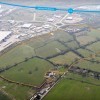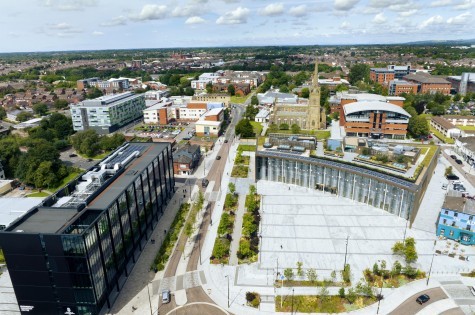Laing O’Rourke director Tom Higgins has worked on some of the most significant, high-profile development projects in the North West, including the Bridgewater Hall in Manchester, the City of Manchester Stadium, Liverpool One and Alder Hey children’s hospital.
He is currently leading on the new Everton Football Club stadium project and says that every major development should incorporate positive, sustainable outcomes and leave a legacy of improvement for communities.
Tom started out as a quantity surveyor and after qualifying in the mid-1980s, spent most of the decade working in Blackpool on projects at Weeton Army Camp, Blackpool Victoria Hospital and Fylde Hospital. He then worked on Royal Lancaster Infirmary.
So, while he is now primarily based in his native Manchester, he knows the county well and his outsider’s view is revealing when comparing where Lancashire stands to its metropolitan neighbours in the battle for investment to carry out regeneration schemes.
He told the conference: “My formative years were spent working up and down the Fylde coast so I know it well. Lancashire should have a joined-up approach.
“For example, Eden Project North should be a Lancashire wide project. You need to look at what challenges can the county meet by developing the Eden Project? What’s the cultural offer, what’s the transportation offer?
“From what I see and hear, Lancashire undersells itself. There’s a lot more here to offer than you put out there. What I have found by and large is, there’s so much to offer, that its almost so good you keep it secret.”
He said the county need joined up thinking and should sell itself and shout from the rooftops about its culture, what is has and what it is good at. A better focus in doing that and attracting more inward investment would be to have an elected mayor with a strategic brief.
Tom said: “From a construction industry perspective, if you don’t do that, you are dead in the water. Everyone around you is doing it, there’s only so much in the pot and if you don’t have it, someone else will.
“Culture drives innovation, innovation drives growth and growth drives economic prosperity. There are areas in Lancashire where you can drive that cultural offering, put an offer out to government and say here’s the 30-year vision.
“What we want to do is generate economic benefit of £2bn over the 30-year period and here’s how we are going to do it. You can’t do that in isolation as Burnley or Clitheroe or wherever, it has to be done as Lancashire.”
He said the approach taken by the metropolitan mayors of Liverpool and Manchester was focused and strategic, but it was not just the mayors making decisions.
Tom said: “They work as a team. They can’t be experts in everything, they have a team of experts around them and take advice. From that collective advice a policy or strategy is put forward. What you would win with a similar approach is an opportunity to develop the skills-base in Lancashire.”
He said certain drivers delivered regeneration at scale. “It comes down to culture, mentality, willingness to listen and to engage with the market in the right way. You don’t want to miss the opportunity to look at the bigger picture. With regard to the regeneration element of these major projects, you want a legacy that will last 25, 30, 40, 50 years.
“Look at the Commonwealth Stadium in Manchester. East Manchester was a challenging environment, I was born and raised in Manchester, so I know it very well, that is part of the drive behind what I do.
“When we got involved with the stadium project it was not unusual to find households in that area with three generations of worklessness - shocking in a first world country. Go to east Manchester now and you would not recognise the area. That stadium was the focus for a complete regeneration.
“It did this because the city council worked in partnership with the contractor, Laing O’Rourke, our supply chain and other partners who saw the vision.
“It is really important that for these major projects you have that bigger vision. The longevity is not the two or three years to procure and build the project. Look at the end date, 30 years down the line, ask what the end game is and work back from that. What is the catalyst? Why is it there? What are the challenges in that area?”
Tom said that while big regeneration projects could deliver sea-changes socially, the industry was facing major problems in recruiting skilled workers which could threaten future projects.
He said: “The skills gap is huge; I can’t overemphasise that enough. Brexit has been a disaster for us. The fallacy was that it would create more opportunities for people in the UK to get jobs. Guess what, no one wants them.”
He said digital skills and modern methods of construction could help alleviate that, by presenting a cleaner more modern image of construction industry and by reducing the dependence on traditional building methods and materials.
Tom believes the government’s nascent plans for Investment Zones could offer some great possibilities, particularly with public and private sector partnership and with the cutting of red tape.
He said: “The private sector involvement is an excellent idea. Public and private sector partnerships, when they are set up properly, work really well.
“They need to cut through planning red tape, which frankly can be an absolute joke. Some planning takes years before you can get to a point where you can actually move forward.”
Enjoyed this? Read more from Ged Henderson



















